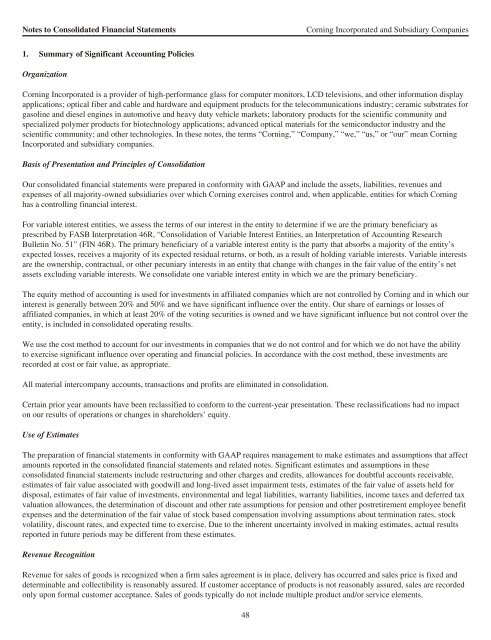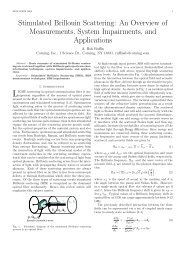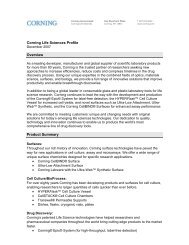You also want an ePaper? Increase the reach of your titles
YUMPU automatically turns print PDFs into web optimized ePapers that Google loves.
Notes to Consolidated Financial Statements <strong>Corning</strong> Incorporated and Subsidiary Companies<br />
1. Summary of Significant Accounting Policies<br />
Organization<br />
<strong>Corning</strong> Incorporated is a provider of high-performance glass for computer monitors, LCD televisions, and other information display<br />
applications; optical fiber and cable and hardware and equipment products for the telecommunications industry; ceramic substrates for<br />
gasoline and diesel engines in automotive and heavy duty vehicle markets; laboratory products for the scientific community and<br />
specialized polymer products for biotechnology applications; advanced optical materials for the semiconductor industry and the<br />
scientific community; and other technologies. In these notes, the terms “<strong>Corning</strong>,” “Company,” “we,” “us,” or “our” mean <strong>Corning</strong><br />
Incorporated and subsidiary companies.<br />
Basis of Presentation and Principles of Consolidation<br />
Our consolidated financial statements were prepared in conformity with GAAP and include the assets, liabilities, revenues and<br />
expenses of all majority-owned subsidiaries over which <strong>Corning</strong> exercises control and, when applicable, entities for which <strong>Corning</strong><br />
has a controlling financial interest.<br />
For variable interest entities, we assess the terms of our interest in the entity to determine if we are the primary beneficiary as<br />
prescribed by FASB Interpretation 46R, “Consolidation of Variable Interest Entities, an Interpretation of Accounting Research<br />
Bulletin No. 51” (FIN 46R). The primary beneficiary of a variable interest entity is the party that absorbs a majority of the entity’s<br />
expected losses, receives a majority of its expected residual returns, or both, as a result of holding variable interests. Variable interests<br />
are the ownership, contractual, or other pecuniary interests in an entity that change with changes in the fair value of the entity’s net<br />
assets excluding variable interests. We consolidate one variable interest entity in which we are the primary beneficiary.<br />
The equity method of accounting is used for investments in affiliated companies which are not controlled by <strong>Corning</strong> and in which our<br />
interest is generally between 20% and 50% and we have significant influence over the entity. Our share of earnings or losses of<br />
affiliated companies, in which at least 20% of the voting securities is owned and we have significant influence but not control over the<br />
entity, is included in consolidated operating results.<br />
We use the cost method to account for our investments in companies that we do not control and for which we do not have the ability<br />
to exercise significant influence over operating and financial policies. In accordance with the cost method, these investments are<br />
recorded at cost or fair value, as appropriate.<br />
All material intercompany accounts, transactions and profits are eliminated in consolidation.<br />
Certain prior year amounts have been reclassified to conform to the current-year presentation. These reclassifications had no impact<br />
on our results of operations or changes in shareholders’ equity.<br />
Use of Estimates<br />
The preparation of financial statements in conformity with GAAP requires management to make estimates and assumptions that affect<br />
amounts reported in the consolidated financial statements and related notes. Significant estimates and assumptions in these<br />
consolidated financial statements include restructuring and other charges and credits, allowances for doubtful accounts receivable,<br />
estimates of fair value associated with goodwill and long-lived asset impairment tests, estimates of the fair value of assets held for<br />
disposal, estimates of fair value of investments, environmental and legal liabilities, warranty liabilities, income taxes and deferred tax<br />
valuation allowances, the determination of discount and other rate assumptions for pension and other postretirement employee benefit<br />
expenses and the determination of the fair value of stock based compensation involving assumptions about termination rates, stock<br />
volatility, discount rates, and expected time to exercise. Due to the inherent uncertainty involved in making estimates, actual results<br />
reported in future periods may be different from these estimates.<br />
Revenue Recognition<br />
Revenue for sales of goods is recognized when a firm sales agreement is in place, delivery has occurred and sales price is fixed and<br />
determinable and collectibility is reasonably assured. If customer acceptance of products is not reasonably assured, sales are recorded<br />
only upon formal customer acceptance. Sales of goods typically do not include multiple product and/or service elements.<br />
48







